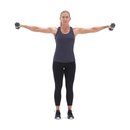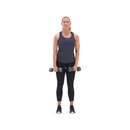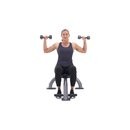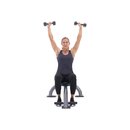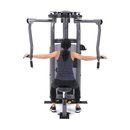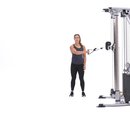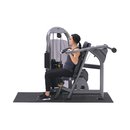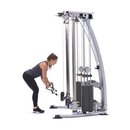Whether you want to hit the stage, the beach, or turn heads in a t-shirt, creating muscular and defined shoulders should be a priority. The delt-to-waist ratio can create a jaw-dropping visual impact that competitors must focus on—and the rest of us shouldn't overlook.
If you're a newbie to lifting, targeted shoulder training can give you the quick gains that will transform your physique in record time. Adding mass to your quads or back is going to take time, but the three deltoid muscles of the shoulder are relatively small, and even a tiny amount of muscle can make an enormous difference to any physique.
As a former Ms. Olympia competitor, and a longtime trainer at Gold's Gym Venice, aka "the mecca," I've seen and performed countless shoulder workouts. These are some of my favorites, starting with a workout for beginners and moving on to a hardcore routine only for advanced ladies.
What Every Woman Needs To Know About The Shoulder
Maybe you're new to the gym, and although you may have come from other sports, lifting weights over your head is new to you. If that's the case, then starting off from an informed position is essential. Before you lift a single weight, let's review the most important aspects of shoulder anatomy and function.
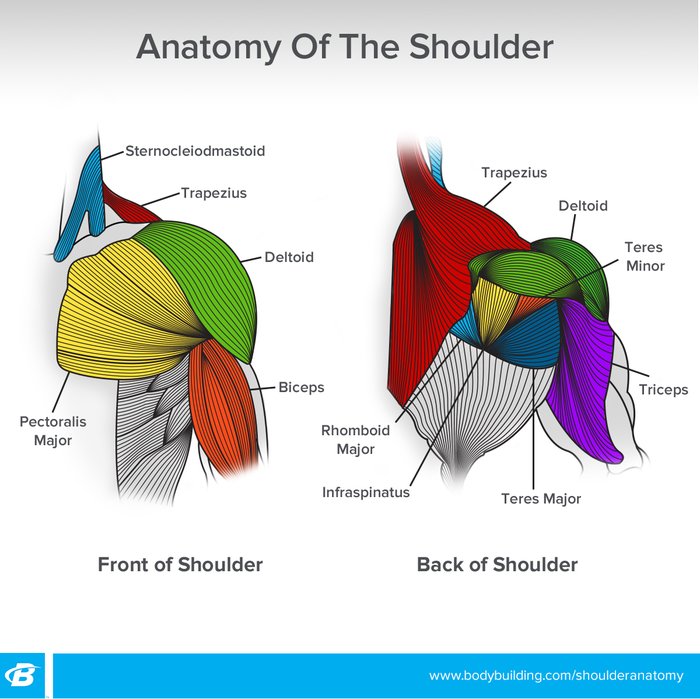
The Shoulder Joint
There are numerous bones and muscles in and around the shoulder, but the three crucial bones to understand are the scapula, aka the shoulder blade behind you; the clavicle, aka the collarbone in front of you; and the humerus, aka the bone of the upper arm.
The shoulder joint, also known as the glenohumeral joint, centers around the point where the humerus fits into an indentation on the scapula known as the glenoid cavity. Numerous muscles connect in and around this joint—really, most of the muscles of the upper body—giving the shoulder a wide range of motion that is both a blessing and a curse.
Why a curse? Because your shoulder mobility can sometimes enable you to lift with seriously sketchy form, whether you realize it or not. More than almost every other body part, using the correct form and increasing your weight conservatively is essential for saving wear and tear on this ball and socket joint. Nothing will impair your progress like a shoulder injury.
The Rotator Cuff
As workout junkies, we love to focus on the mirror muscles, but for a moment let's acknowledge what holds it all together: the rotator cuff. The four rotator cuff muscles are the infraspinatus, the supraspinatus, the teres minor, and the subscapularis. This team works together to stabilize the shoulder and to keep the humerus in the glenoid cavity.
In other words, they keep your arm attached to your body, but also help ensure that the humerus stays centrated in the joint and follows a safe movement path. This is why you'll find so many articles dedicated to this incredibly talented set of muscles, and how to activate them for safe, strong lifting.
The Delts
OK, let's finally talk about what most of us associate with the term "shoulder muscles"—the delts!
The deltoid is a triangular muscle group that covers the shoulder joint. Its round shape stretches from the top of the shoulder to the clavicle at the front and the scapula at the back, and as it drapes over the joint, it attaches to the upper arm bone.

The deltoid works to raise the arm, rotate the arm, assist the pectoral muscles, and protect against dislocation when we carry heavy objects. That's a lot of functions for such a small muscle.
The deltoid has three portions or "heads" with three distinct functions, although they all chip in to some degree on compound movements like shoulder presses.
- Anterior deltoid: The anterior deltoid lifts the arm to the front and rotates the arm medially, or toward the midline of the body. The primary isolation movement for anterior delts are variations of front raises, which you can vary by using different hand positions—palms face in, palms face down, etc.
- Lateral deltoid: The middle abducts the arm, or lifts it away from the body. Exercises for the lateral deltoid include any form of side raise, as well as an upright row—particularly with a wide grip.
- Rear deltoid: The posterior or rear delt extends the arm behind the body and rotates the arm outward. Exercises for the rear deltoid include face pulls, the reverse pec-deck machine, reverse cable fly, and bent-over lateral raises, among others. Because rotation is one of its functions, hand position can create variations to any standard movement.
A Quick Word On Traps
Another massive component to any shoulder workout worth mentioning is the involvement of the trapezius muscles. The "traps" elevate and rotate the shoulder. The upper trap attaches to the clavicle (front), the scapula (back), and to the back of the skull.
You may or may not want to focus on building your trapezius muscles. Men often love big traps and will train them in isolation. Women may choose to do the same, but often don't because traps that overpower the delt can make the shoulders look narrower.
More important for this article, though, is acknowledging that poor form on shoulder movements, and too much movement of the scapula, will activate the traps and lead them to "take over" shoulder movements.
I see this all too often when someone uses too much weight on a lateral raise. The arm does indeed raise, but the delt had little to do with it. If you let the traps do the work, they will—at the detriment of other muscles.
To keep the traps from taking over your shoulder workout, keep your shoulders down, away from your ears, and use moderate weight. Nobody cares how heavy you can perform shoulder isolation movements, and, when in doubt, lighter is often better.
Beginner Shoulder-Building Workout
Unless we are involved in sports, day-to-day living rarely requires us to lift things above our head. If you are new to working out, please do not go straight into a heavy overhead press. Do a thorough warm-up, and then hit the shoulders in slightly higher rep ranges. A good shoulder workout should burn!
Use seriously light dumbbells for this routine, like 2-3 pounds. Perform all the movements standing with your knees slightly bent, which will take the pressure off the lower back.
Don't overlook this warm-up! It's the same one that I do to this day.
Workout Notes:
Repeat this workout twice a week, with at least 72 hours in between each workout. Your form will start to feel locked in at about week 2 or 3, then you can start to increase the weights and use other variations of the same movements.
When you see the reps decreasing, it indicates an increase in the weight you should use. But remember, reps aren't a hard-and-fast rule—they're a guide. If the workout says 12 reps, but you can get 3 more with good form, do the extra 3 reps. Then, increase the weight slightly during the next set. Alternately, if the sets say 12, but you can barely get 8, reduce the weight. Never sacrifice form for weight!



Technique Keys
Seated Dumbbell Press
Using a shoulder machine might give you a little extra initial strength, but in this workout, I focus on the seated dumbbell press. The free weights will force the stabilization you are going to need as the load increases, while performing the movement seated will enforce stricter form than performing it standing.
The dumbbells do not need to touch overhead; if your hands come narrower than your shoulders, you are potentially compromising the shoulder joint.
Standing Front Raise With EZ-Bar
You can also use a low cable for this movement. No matter what implement you choose, keep the knees slightly bent, which will stop you from rocking and will protect your lower back. Also use a false grip, which means thumbs on the same side of the bar as your fingers, as you lift the bar to chin level. Always control the descent. Keep your body still and keep your neck long.
Seated Lateral Raise
I'm having you sit down here to keep your form strict. This is one of the most abused exercises I've seen in all my 35 years of lifting weights! Engage your lower back muscles, and you will feel your shoulders getting pulled down into place. Keep this feeling. Imagine that you are sitting between two planes of glass. If the dumbbells go too far in front or too far behind you, you will break the glass.
Then, lift the weight as if the resistance is on the top of your elbows. Your thumbs should be pointing slightly down. If your thumbs and palm start to creep up, you will feel that your whole shoulder has changed position and the lateral delt is no longer doing much of the work.
Practice this exercise with very manageable weights until your form is perfect.
Reverse Machine Fly
Move to a rear delt fly machine. Adjust the seat height so that your shoulders are comfortably depressed into your ribcage. If you sit too low, your traps will get very involved.
Keep a neutral wrist position—it can tend to drop—and be sure that your elbows are pointing behind you, not at the floor. Imagine that you are about to elbow someone behind you. Not a polite thing to do, but that's where your elbow should be.
Women's Overall Shoulder-Building Workout
This workout is for someone who isn't new to lifting, who wants to add quality size to each part of their deltoid, is pain-free, and understands good form. If you're wanting to add size, it'll help you do that, but if you're trying to slim down and just want your shoulders to stand out and look "toned," it fits the bill there, too.
Because this is an intense workout, I only recommend performing it once a week. Each time you do, I recommend switching variations of the same movement: dumbbell, machine, cable, barbell, and so on. I'll give specific examples.
No matter what movement you select, though, you should start with the same warm-up I used in the beginner's workout. Trust me: It works!

Technique Keys
Overhead Press
Choose between a seated dumbbell press, a machine press, or a seated barbell press. One week do dumbbell, the next do a machine, and so on. Squeeze your lower lats to depress your scapula, engage your abs with a breath, and press. Bring the weight down to chin height, don't bring your chin up to the weight!
When you do dropsets, reduce the weight by about a third and go to a controlled failure. So, 30-pound dumbbells would be dropped to 20 pounds.
Take your time between sets. If you like to keep a fast-paced workout, hit an ab move or stretch your shoulders.
Lateral Raise
As with the presses, change it up each week. Choose between using dumbbells or a machine, and between double or single-arm raises. For muscle-building, I'm not a fan of using cables for lateral raises, but if it works for you, go ahead. Keep your form tight and enjoy the burn of the dropsets.
Dumbbell Rear-Delt Row
This is a heart-pumping superset that doesn't take strength away from either exercise. You have options, too; any combination of a machine and a cable or free weight will work. For this movement, you could use a bent-over dumbbell row (either seated or standing), a cable reverse fly, or a machine. If your gym is busy, just put a pair of dumbbells next to the machine you're using for the other movement.
If you use dumbbells, keep your knees bent with shoulders higher than your hips. What you're looking at will dictate the position of your neck, so keep your eyes about 4 feet in front of you, so that your neck neither has to overextend or flex.
The elbows are bent, and the arm stays in the same position throughout. If the weight is too much, it can look like a lousy triceps extension.
Front Cable Raise
You can use a rope, handle, or bar. I prefer the short EZ-bar. The weight you use on a cable front raise will depend on the machine you're using. Some machines are great for your ego, and some make this exercise almost impossible. You're keeping the reps a little higher because otherwise the forearms take a beating, and the elbows can complain afterward. A great alternate choice for this movement is the alternating front dumbbell raise.
Women's Width-Building Shoulder Workout
Make those shoulders pop by putting the focus on the lateral deltoids! This may be a routine you want to implement for 4-6 weeks, or it may be one that you use every third shoulder workout, alternating it with some of the other workouts here.

Technique Keys
Seated Smith Machine Behind-The-Neck Press
Many people's shoulders can tolerate this. Some definitely can't. If it hurts you, don't try to struggle through—use a different movement instead, like a dumbbell press or a Smith machine press in front of the neck.
Be sure to position your seat correctly under the bar and be aware if the Smith is vertical or slightly angled. The weight you use will depend on the machine. Only go as low as feels good for your shoulders, and use a grip wider than shoulder width.
You may choose to have the bench back up for support or to keep it flat, or even to have a training partner put their knee in the center of your back. I learned that one from my old training partner, Robbie Robinson.
Standing Dumbbell Lateral Raise
Don't go any higher than 90 degrees on these, because beyond that point, it's pretty much all trap. Keep the palms facing the floor, and don't swing the dumbbells—or your body.
Bent-Over Low Pulley Lateral Raise
Perform these rear-delt scorchers one arm at a time, doing all the reps for a set with one arm, then the other, and then going right into the other half of the superset. No matter which cable you use, this is going to feel heavy, but it gives a unique soreness that you might like. Keep your hips and shoulders square with the floor.
Dumbbell Lateral Raise With "Slide"
For this burner of a move, use half the weight of what you would use for a regular lateral raise.
Raise your arms to the side, and when the weights are at chest height, bring your arms across your body until the dumbbells touch end to end. Return immediately to the extended position and return the weights to your side.
Keep the rep range moderate, as the forearms and elbows can feel the strain if they become too overloaded.
Cable Single-Arm Lateral Raise
The lateral delts will be tired by now, so move on to a single-side movement where you can focus on control.
If the cables in your gym are too heavy for this exercise, use a very light dumbbell instead. When using a dumbbell, you can hold on to the frame of a machine or to the back of a gym bench. By securing your non-working side you can avoid swaying with each rep.
Women's Advanced High-Volume Shoulder Workout
You're an experienced lifter, looking to shake up your shoulder workout and shock the muscles into some new development. Well, get ready! This a personal favorite workout of mine, but it's a lot of work. You'll do eight exercises, totaling 40 sets, with both high and low reps. You can use this workout weekly for 4-6 weeks, or alternate it for every other shoulder workout with any of the other less-intense workouts here.
There are two exercises for each part of the delt, and two pressing movements that involve all three heads. One exercise is on a machine, and one is with free weights. Each exercise is coupled with another. The first exercise is structured in descending reps with increasing weight, and the second exercise keeps the same weight and reps for each set.
If you're an advanced enough lifter to handle this workout, then you probably don't need much in terms of technique cues. I'll just say this: Use the implements that are safest and most comfortable for you, and stay in control of the weight. If you don't have access to a machine for lateral raises, either a resistance band or a single cable raise will work. And on all moves, don't be afraid to lift lighter than you would for a workout with less volume.





